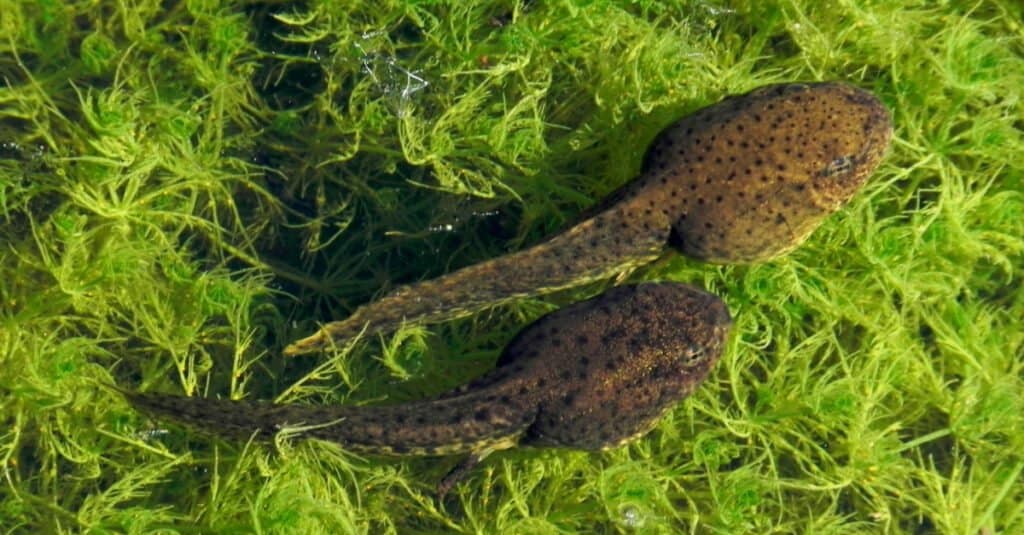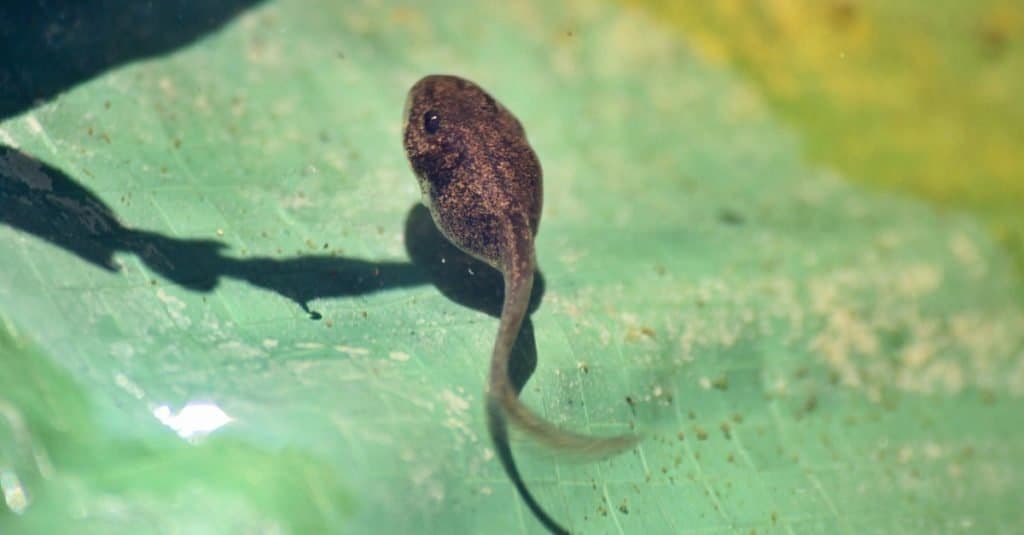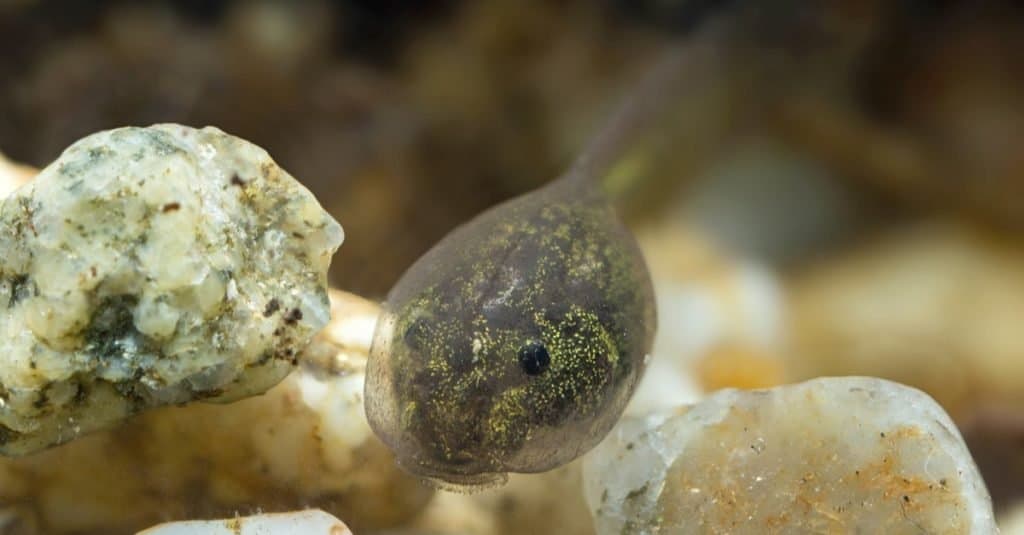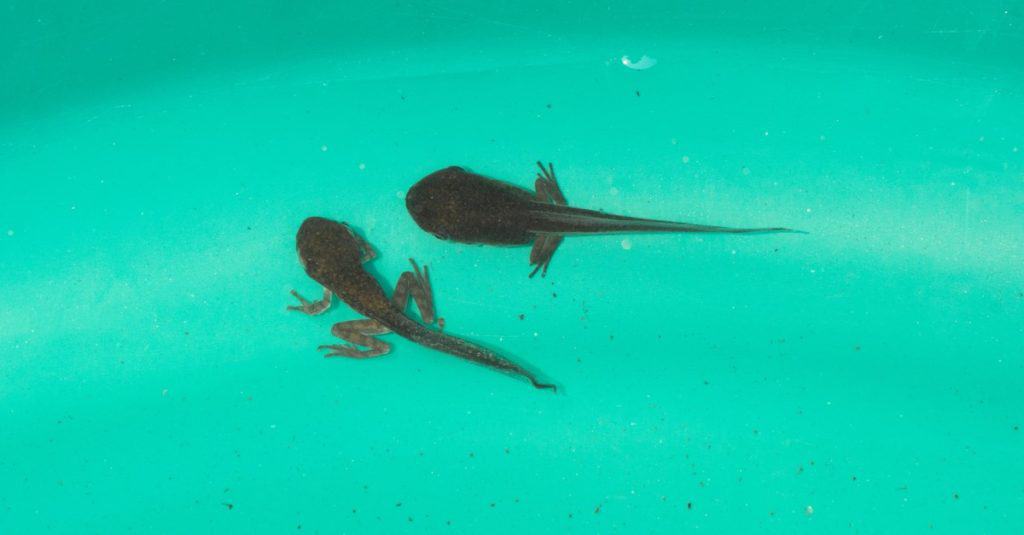Many animals go through a larval stage before eventually evolving into an adult. One of the most well-known examples of this is the tadpole, which is the larval stage of a frog or toad. In appearance, they look like globular fish with long, tapered tails. The majority of tadpoles spend the bulk of their time in the water, although some do live on land.
As they grow, tadpoles eventually undergo metamorphosis and change from their larval form into their adult form. As a result, they lose their tails and begin to take the shape of a fully mature frog or toad. At the same time, their diet and behaviors also change. Tadpoles will begin to eat different foods and spend time in other environments. Due to their changing appearance, habitat, and diet, this begs the question, “what do tadpoles eat?”
In order to answer this question, we’ll do a deep dive into the dietary habits of tadpoles. We’ll begin with a general discussion of what tadpoles like to eat. Then, we’ll move on to an examination of how tadpoles hunt and forage for food. Next, we’ll look at what tadpoles eat in the wild. Finally, we’ll end with an exploration of what pet tadpoles eat. So, let’s get cracking and answer the question, “what do tadpoles eat?”
What Do Tadpoles Like to Eat?

During their life stage cycle, tadpoles undergo rapid transformation. Their bodies quickly adapt and change, and as a result, their diets change as well. Therefore, it’s inaccurate to state that all tadpoles like the same foods. This is because the food that a tadpole eats varies according to a number of factors. For example, shortly after birth, most tadpoles are herbivores and eat mostly plant matter.
As they grow and their bodies change, most tadpoles are able to eat more foods and their diet becomes increasingly omnivorous. Near the end of the larval life stage, most tadpoles eat an almost exclusively carnivorous diet. Additionally, a tadpole’s diet can also vary depending on the region where it lives or the local environment.
That being said, there are some foods that occur frequently in a tadpole’s diet. 10 foods that tadpoles usually like to eat include:
- Algae
- Aquatic Plants
- Vegetables
- Larvae
- Worms
- Insects
- Other tadpoles
- Carrion
- Plankton
- Small fish
How Do Tadpoles Hunt and Forage For Food?

Tadpoles are active foragers and scavengers but will cease actively feeding if they risk predation.
©Joshua Ouellette/Shutterstock.com
While tadpoles possess many of the same senses as humans, their senses are not as evolved as ours. As such, they must rely on their innate instincts and certain cues to find food and avoid predators. One of a tadpole’s most important senses is its sense of touch. They rely on touch-sensitive neurons in their heads that help them to feel their environment.
Research suggests that tadpoles can see, although not very well. They are able to distinguish colors and shapes and can also detect changes in light. Experiments have also been done that allow tadpoles to see with eyes transplanted onto their tails! Additionally, tadpoles can detect odors that allow them to sense predators and other tadpoles. This may be especially helpful when scavenging. While tadpoles do have a rudimentary sense of hearing it is not as evolved as it is in adult frogs and toads.
From birth, tadpoles are hardwired to seek out the nearest source of food and to seek shelter from predators. To accomplish these goals, tadpoles engage in active foraging and scavenging unless they perceive a nearby threat. In order to mitigate threats, some tadpoles form schools, thereby increasing the likelihood of avoiding predation and increasing the odds of finding food. Tadpoles utilize a number of methods while hunting, scavenging, and foraging.
One method used includes filter-feeding plankton and small organic matter from the water. Another includes scraping algae and other aquatic vegetation from the bottom of rocks or plants. Older tadpoles will also actively hunt small insects and other animals, which they generally swallow whole. When present, tadpoles will also scavenge for carrion. If no other food is available, they will turn on smaller or weaker tadpoles and cannibalize their own kind.
What Do Tadpoles Eat in the Wild?

In the wild, tadpoles start out eating algae and vegetable matter before moving on to small insects.
©greggnormal/Shutterstock.com
In the wild, tadpoles will eat pretty much anything that they can find and which they are adapted to digest.
Shortly after birth, the first thing that most tadpoles eat is their own embryonic fluid. This provides them with enough protein and nutrients to survive until they can find food. The next food that most tadpoles move on to is algae. At this early stage, tadpoles possess a long intestinal tract that is specially designed to digest vegetable matter.
Over the coming days and weeks, tadpoles will also eat the roots and leaves of other aquatic plants like duckweed. Once they are large enough, tadpoles will begin to eat more animal matter. Common prey include small insects such as aphids and fruit flies.
They will also target grubs, worms, and other insect larvae. Especially large species may eat small fish or fairy shrimp, and may even eat other tadpoles.
What Do Pet Tadpoles Eat?

You can feed your pet tadpole vegetables as well as fish flakes or algae flakes.
©Macrolife/Shutterstock.com
Just as frogs are commonly kept as pets, some people choose to raise tadpoles for personal or commercial reasons. If you have a pet tadpole, you’ll need to keep track of its eating habits and dietary needs closely.
Remember, a tadpole’s feeding behavior changes as it grows, which means you’ll need to adjust its diet accordingly. During the first 1 to 2 weeks of life, you can feed a tadpole some fresh greens and vegetables. Safe options include lettuce or broccoli.
Along with veggies, make sure your tadpole has access to some form of fresh algae or commercial algae flakes. You can supplement its diet with commercial tadpole pellets, as well as fish flakes.
At around 2 to 4 weeks old, you can begin to feed tadpoles insect larvae and more fish flakes or other animal protein. Common options include shrimp flakes, crickets, and bloodworms.
What Should You Not Feed Tadpoles?

Never provide tadpoles with food for other animals such as cats, dogs, or turtle kibble.
©Heffalum/Shutterstock.com
As tadpoles grow, observe their behavior to gauge their readiness for different snacks. Nevertheless, certain foods should be completely avoided since tadpoles lack the ability to digest them.
Never provide these amphibians with commercial pet food designed for other animals, such as dogs, cats, or even turtle kibble, as it can prove fatal for them.
Larvae and insects captured from the wild are also thought to be unfavorable for a captured or pet tadpole. Basically, you don’t know where wild insects have been or what they have fed on. They may also harbor diseases and parasites that could be harmful.
Lastly, nutritionally deficient foods should be avoided.
The photo featured at the top of this post is © iStock.com/Suwatwongkham
Thank you for reading! Have some feedback for us? Contact the AZ Animals editorial team.






